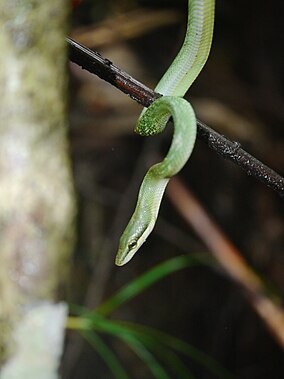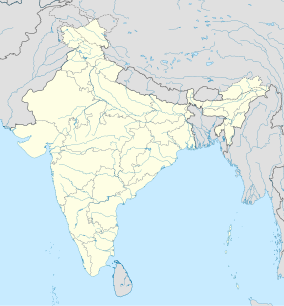Dehing Patkai National Park
This article needs additional citations for verification. (August 2012) |
| Dehing Patkai National Park | |
|---|---|
 Young Green Trinket Snake in Dehing Patkai National Park | |
| Location | Dibrugarh and Tinsukia, Assam |
| Nearest city | Khonsa, Naharkatia, Duliajan, Dibrugarh |
| Area | 231.65 km2 (89.44 sq mi) |
| Established | 2004 |
| Governing body | Government of Assam |
Dehing Patkai National Park is a national park in the Dibrugarh and Tinsukia districts of Assam covering an area of 231.65 km2 (89.44 sq mi) of rainforest.[1][2] It was declared a wildlife sanctuary on 13 June 2004. On 13 December 2020, the Government of Assam upgraded it into a national park.[3] On 9 June 2021, the Forest Department of Assam officially notified it as a national park.[4] It is located in the Dehing Patkai Landscape which is a dipterocarp-dominated lowland rainforest. The rainforest stretches for more than 575 km2 (222 sq mi) in the districts of Dibrugarh, Tinsukia and Charaideo. The forest further spreads over in the Tirap and Changlang districts of Arunachal Pradesh. Dehing Patkai National Park harbours the largest stretch of lowland rainforests in India. Dehing Patkai Wildlife Sanctuary was declared as Dehing Patkai Elephant Reserve under Project Elephant.[5][6] Dehing-Patkai as a potential wildlife sanctuary was identified in late 1980s during a primate survey as "Upper Dehing Wildlife Sanctuary".[7] Subsequently during a study on white-winged wood duck in early 1990s, it was discovered as a globally important site for this duck and recommended to be upgraded to "Upper Dehing National Park".[8]
Climate[edit]
The climate of the region is mostly tropical with an annual rainfall of more than 4,000 mm. Monthly precipitation is at least 60 mm.[citation needed]
Wildlife[edit]
Fauna[edit]
Being a rainforest, this National Park is very rich in biodiversity. It is an ideal habitat for non-human primates. The species are slow loris, Assamese macaque, stump-tailed macaque, pig-tailed macaque, Rhesus monkey, capped langur and hoolock gibbon.[9] So far, nearly 50 mammal species, 47 reptile species and 310 butterfly species have been recorded. Other noteworthy mammals found in this national park includes Chinese pangolin, dhole, Himalayan black bear, Malayan sun bear, crab-eating mongoose, small-toothed palm civet, binturong, jungle cat, leopard cat, Asian golden cat, marbled cat, Bengal tiger, leopard, clouded leopard, Asian elephant, gaur, red serow, sambar, barking deer, Red giant flying squirrel, Malayan porcupine and Asiatic brush-tailed porcupine.[10]
Avifauna[edit]
This section possibly contains original research. (May 2017) |

Dihing Patkai rainforest harbours about 293 bird species, belonging to 174 genera and 51 families. The majority is resident (63.7%), some are winter visitors (23.1% ), and very few are summer visitors (2.5%). About 10.7% are altitudinal migrants, coming mainly from the higher reaches of the western, central and eastern Himalayas. Avifauna includes white-cheeked partridge, kalij pheasant, grey peacock pheasant, Oriental darter, lesser adjutant, white-winged wood duck, pied falconet, slender-billed vulture, white-backed vulture, greater spotted eagle, besra, black baza, osprey, pale-capped pigeon, green imperial pigeon, mountain imperial pigeon, red-breasted parakeet, Oriental bay owl, tawny fish owl, great pied hornbill, brown hornbill, wreathed hornbill, yellow-vented warbler, hill myna and scaly thrush. However, it is the white-einged wood duck, the State Bird of Assam for which the park is justly famous.[11][12]
Flora[edit]
The different trees of this four-layered rainforest are laden with many exotic species of orchids and bromeliads. There is an abundance of ferns, epiphytes, wild banana, orchids, arums, climbers and lianas in this humid forest habitat. Some of the important tree species found in this forest area are – Hollong, Mekai, Dhuna, Uriyam, Nahar, Chamkothal, Bher, Hollock, Nahor, Ou–tenga (elephant apple), different species of Ficus spp. etc. The towering Hollong tree which is also the State Tree of Assam dominates the emergent layer of this rainforest.
The forest type according of Champion and Seth's classification is Upper Assam valley tropical evergreen forest.
The important species of over wood are Dipterocarpus macrocarpus, Mesua ferrea, Castanopsis indica, Shorea assamica, Vatica lanceaefolia, Amoora wallichii, Dysoxylum binectiferum etc. The other species found in understorey are Garcinia lanceifolia, Michelia muni, Baccaurea sapida, Bischofia javanica, Myristica limifolia etc. The shrub and herb layer has Glochidion spp., Alpinia spp., Mallotus philippinensis, wild banana, tree fern, pepper etc. The ground cover mainly has Melastoma, Leea and other species.
Ethnic groups[edit]
The Dihing Patkai Forest region has a rich cultural heritage. There are more than a dozen different ethnic groups living in the area including the indigenous Assamese communities, particularly Tai Phake, Khamyang, Khampti, Singpho, Nocte, Chutia, Ahom, Kaibarta, Moran, Burmese, and Nepali people. Tea-tribes were brought by the British to work in the tea plantations.[citation needed]

References[edit]
- ^ Chakraborty, Avik (7 December 2020). "Environmentalist hails Assam government's decision to upgrade Dihing Patkai Wildlife Sanctuary into national park". nenow.in. Northeast Now. Retrieved 14 December 2020.
- ^ Dehing Patkai Wildlife Sanctuaries Archived 17 May 2013 at the Wayback Machine Department of Environment & Forests, Government of Assam, Retrieved 2 September 2015
- ^ Bureau, Pratidin (14 December 2020). "Dehing Patkai Upgraded to National Park". pratidintime.com. Pratidin Time. Retrieved 14 December 2020.
- ^ Bureau, Pratidin (9 June 2021). "Dehing Patkai Declared National Park, 7th in Assam". pratidintime.com. Pratidin Time. Retrieved 9 June 2021.
- ^ Bhattacharjee, J. (2013). "Exploring Environmental Movements in Assam: Some Case Studies" (PDF). Environmental activism in North East India: exploring environmental movements and action groups with special reference to Assam (PhD thesis). New Delhi: Jawaharlal Nehru University. pp. 91–118.
- ^ Sharma, N. (2020). "Dehing Patkai: A survivor once again". The Hill Times. Vol. XXI, no. 151. p. 4.
- ^ Choudhury, A. U. (1989). Primates of Assam: their distribution, habitat and status. Guwahati: Gauhati University.
- ^ Choudhury, A. U. (1996). Survey of white-winged wood duck and Bengal florican in eastern Assam and Arunachal Pradesh. Guwahati: The Rhino Foundation for Nature in NE India.
- ^ Choudhury, A. U. (1989). Primates of Assam: their distribution, habitat and status. Guwahati: Gauhati University.
- ^ Choudhury, A. U. (2013). The mammals of North East India. Guwahati: Gibbon Books and the Rhino Foundation for Nature in NE India. ISBN 978-9380652023.
- ^ Choudhury, A. U. (1996). Survey of white-winged wood duck and Bengal florican in eastern Assam and Arunachal Pradesh. Guwahati: The Rhino Foundation for Nature in NE India.
- ^ Choudhury, A. U. (2000). The birds of Assam. Guwahati: Gibbon Books and the WWF-India NE Region Office. ISBN 8190086618.
External links[edit]


 French
French Deutsch
Deutsch

